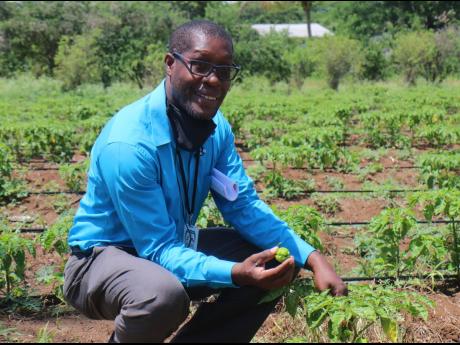Sydney Pagon expands agro food processing curriculum
Students to learn cassava flour production
Come September, students at Sydney Pagon Science, Technology, Engineering and Mathematics (STEM) Academy in St. Elizabeth will have the option of learning how to make cassava flour and tap into the economic potential of the local produce.
The school’s administrators said they are using the summer break which started in June as a testing phase, and are also going through the necessary certification processes before making it part of the school’s agro food processing curriculum.
Milbert Miller, principal, Sydney Pagon STEM Academy told The Gleaner that this new build-out in the school’s offering is as a result of the $47-million 2,200 sq. ft. Elim Agro-Processing Plant which was handed over to the school on March 24 by J. Wray & Nephew Limited Foundation.
The agro-processing plant has the ability to dry, mill, package and store items which would normally go to spoil.
J. Wray & Nephew Limited Foundation made the donation following the closure of the Appleton Estates Sugar Factory in 2020. Through this, the Foundation will continue to support the parish’s farmers, who now have the opportunity to offer value-added products, in addition to their primary crop production.
With this equipment at the school, farmers will be able to take crops and turn them into chips and other products for baking and frying or for the transitioning of crops, such as breadfruit, sweet potato and other produce, into powders and flour.
Miller believes there is potential gain from the production of cassava flour at the school and said there are markets already waiting for the packaged flour-based products the school plans to sell.
“We are estimating that, if, for example, we’re doing cassava, we can do up probably about 2,000 lbs roughly of flour on a weekly basis at the minimum level,” he told The Gleaner.
He said discussions are being held about the production levels.
Miller said the school did processing in the past, but not with this type of technology. Additionally, with the new technology, students pursuing agro processing at Sydney Pagon STEM Academy will have the opportunity to gain NCTVET certification.
“In the past, the school used a small mill for production on a small scale and the new machine will help them to increase. We are hoping that at the end of grades 12 and 13, we should at least have them [students] certified at level two or level three at the HEART [NSTA Trust] certification level in agro food processing. That is the aim on the school’s side,” he explained.
He added, “However on the production side where the facility is concerned, we are hoping that the facility will be producing ... for both the local market as well as the export market.”
The school had a machine which they used for breadfruit flour, sweet potato, pumpkin and other flour production. It was during this processing that the whole idea started of using solar dehydrators to dry breadfruit and making it into flour, which they did for a year.
However, there are questions about the merit of the investment in cassava bread as there is not a high demand for the product.
Lenworth Fulton, president of the Jamaica Agricultural Society (JAS), said it is encouraging to know that the school is considering to produce more cassava flour.
He recalled cassava flour being used significantly in Jamaica in the past, but the product is now generally used to make bammy.
Economic sense
“[The success of cassava flour] would need us producing cassava efficiently on the best lands with irrigation so that the yields would make economic sense. It was being tested by one of our bakery. They had gone up to using 15 per cent of cassava flour mixed with the wheat flour and you could not discern any difference in the taste of the baked products,”
He noted that Red Stripe has been using cassava flour as the starch component in their beers.
Fulton believes that Jamaica has the potential to have a fully developed cassava industry in Jamaica for gluten-free flour to be produced based on numerous trials undertaken over the years.
“We are not short of the scientific knowledge, not short of practices. We do have good soil type here that can do cassava, so it is a good product to use and the starch substitute in our animal feed,” he said.
Anthony Chang, chief executive officer at Purity Bakery says his bakery has chosen not to make a lot of cassava bread products since they launched the product in 2019.
“When we started, we didn’t expect it to be a whole lot. The cassava flour is more expensive than the regular flour, so what we wanted to do is use a high percentage of cassava flour to give you a nice local feel, but the price was just an issue at the time. Now, we’re revisiting it because things have changed, since the last couple months. We’re revisiting the whole thing,” Chang told The Gleaner.
Another proprietor, Derrick Nembhard, managing director of ADM/Jamaica Flour Mills said Jamaica certainly has the ability to grow cassava, but the problem lies with the amount of cassava which one needs to make one pound of flour, which is sometimes four lbs to make one lb of flour.
“Right now with the type of production we have, it is not a viable option as a replacement for wheat flour, but it is certainly a viable option as far as specialty flours are concerned, either cassava flour by itself or as an additive to wheat flour or as a gluten-free product,” Nembhard told The Gleaner.
He said his company is now conducting research on it for gluten-free products.
Nembhard said his company also uses breadfruit flour, cassava flour and sweet potato flour either individually or combined.


